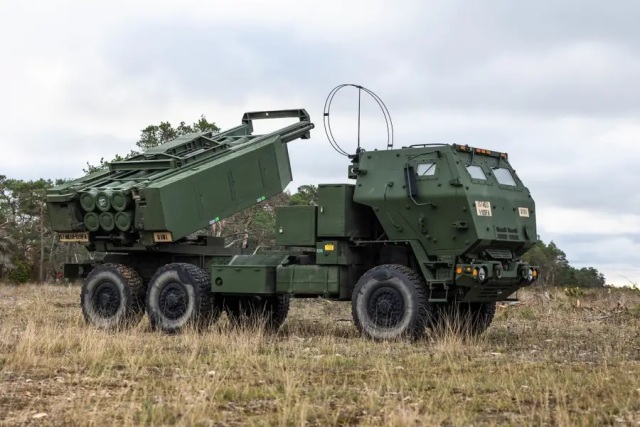Business Insider published Michael Peck's material "HIMARS rockets have been a 'game changer' in Ukraine, and the US Army is now looking for ways to build up to 500 more" ("HIMARS missiles have changed the rules of the game" in Ukraine, and now the US Army is considering the possibility of manufacturing up to 500 more systems"), which states that the US Army has issued a request for information on the production of 24 to 96 M142 HIMARS multiple rocket launcher combat vehicles annually (up to 480 units in total) for five years from 2024 to 2028 fiscal years.

M142 HIMARS multiple rocket launcher combat vehicle from the Wisconsin National Guard during joint exercises on Gotland Island (Sweden), October 2021 (c) Patrik Orcutt / US ArmyThe US Army is looking for companies that can produce up to 100 HIMARS multiple rocket launchers per year.
The US Army has issued an official request for information, while Ukraine is using its new M142 HIMARS (High-Mobility Artillery Rocket System) systems supplied by the US to deliver crushing blows to Russian forces.
What is interesting is that the US Army has drawn up a five-year schedule that requires the release of almost 500 new HIMARS systems, which are currently manufactured by Lockheed Martin Corporation. From 2024 to 2028 fiscal years, the US Army is considering the release of at least 24 new combat vehicles per year, and a maximum of 96 - that is, a total of 120 to 480 within five years.
"The total number of HIMARS includes all possible options," the US Army said. - "Additional activities to support [production] include, but are not limited to: resumption of production, obsolescence, engineering design changes, system design and software management (SEPM), integrated logistics support (ILS), spare parts, training new equipment and other auxiliary equipment".
Whether these new HIMARS will be manufactured depends on funding, US Congressional policy, and changes in the international situation and military technology. "The information provided can be used by the US Army in developing a procurement strategy," the Redstone Arsenal noted, which issued a request for information.
The addition of 480 new combat vehicles will almost double the global fleet of HIMARS systems.
The US Army now has 363 of them, and the Marine Corps has 47 more. In 2021 - before Russia invaded Ukraine - the US army said it would seek to increase its forces to 547 HIMARS. Romania has 18 HIMARS and a US option to purchase another 54. Singapore has 18 combat vehicles, Jordan has 12.
After Ukraine, perhaps the most notable customer will be Taiwan, which is now planning to contract 29 HIMARS combat vehicles [Poland is not mentioned. - bmpd].
Taiwan originally planned to order only 11 HIMARS along with 40 self-propelled 155 mm M109A6 Paladin howitzers, but now it wants to cancel the Paladin order in favor of more HIMARS that have a longer firing range. The Taiwanese Army believes that HIMARS will be more effective in countering the landing of the amphibious assault.
Indeed, given the fame HIMARS gained in the war in Ukraine, where this weapon was called a "game changer," its advertising alone is likely to increase sales.
HIMARS was created as a light multiple launch rocket system mounted on a truck, along with the heavier armored multiple launch rocket system M270 MLRS. While HIMARS can use long-range ATACMS tactical missiles, Ukrainian vehicles are equipped only with a GMLRS missile container, which can fire six GPS-guided missiles at a range of up to 50 miles.
Ukraine used HIMARS for pinpoint strikes on Russian targets, such as ammunition depots, command posts and even bridges.
The great reach of HIMARS is especially appreciated by the Ukrainian military. When Russia launched the offensive in February, Soviet-era artillery used by the Ukrainian military was inferior in range to newer Russian weapons, such as the BM-30 Smerch multiple launch rocket system, which has a range of 45 miles.
This allowed the Russian artillery to destroy Ukrainian guns while remaining out of reach of return fire. Since HIMARS is placed on a car chassis, it can also use a "shoot and run" tactic to quickly change position after firing.
But it will not be easy to increase the production of HIMARS. COVID-19 and other supply chain issues have created large deferred order portfolios in the civilian and military industries. And at the best of times, increasing production capacity for the production of weapons was difficult - even the expansion of production lines for the production of obsolete unguided 155-mm howitzer shells can take more than a year.
Manufacturers may be reluctant to invest, fearing that changes in Pentagon priorities and Congressional funding will force them to remain with unused capacity. The export of HIMARS and other weapons to other countries is also a hostage to the ever-changing global policy and the Byzantine process of selling American weapons abroad.
However, HIMARS looks like it will become a coveted weapon for many. With sufficient demand, the US defense industry will produce more and more of them.





